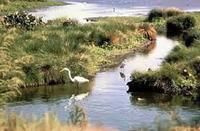FREE Bachelor of Landscape Architecture Environmental Science Ecology Questions and Answers
Energy rises in an energy pyramid.
If the main producer level has 100 units of energy, the top level of the pyramid will have roughly 10. As you ascend levels, the energy pyramid shrinks.
What fuels all life?

The Sun powers all life on Earth. Photosynthesis converts sunlight into chemical energy that plants pass on to other species in the food chain. The Sun powers all living things.
Food chains represent what?

Food chains depict energy transfer between organisms in an environment. Herbivores (primary consumers) devour plants (producers), which are subsequently eaten by carnivores (secondary consumers), and so on. As creatures are eaten, energy moves up the food chain.
Which of the following sums up a community the best?
A community is a group of species that share an ecosystem. Sharks, groupers, anemones, and shrimp on a coral reef are a community because they live and interact in the same habitat. Each species has its own ecological purpose and interacts with other community members in diverse ways, generating intricate interactions and dependencies. The coral reef ecosystem supports various species and ecological balance.
Herbivores are which?

Herbivores eat plants. Crickets are herbivores since they eat plants. Shrew, hawk, and frog do not eat plants. Shrews, hawks, and frogs consume insects and other small creatures.
The diagram depicts what type of growth?

In nature, exponential expansion is a frequent occurrence. It is seen in the development of germs, the spread of illnesses, and the expansion of plant and animal populations. The exponential rise of the internet and financial markets are two examples of human-made systems that exhibit exponential growth.
Match the picture to its group/term, Rabbit.

Rabbits match "Organism." An organism is an independent living being. The rabbit represents a solitary living organism among ecosystems, communities, and populations. Organisms are solitary animals, plants, or other living things.
Which thin layer supports life and has the highest ecological organization?
Biosphere is right. Life occurs in Earth's limited atmosphere. It includes all living things and their interactions with non-living things. The biosphere encompasses ecosystems, communities, populations, and individuals worldwide. It is the highest ecological organization since it integrates all living things and their interactions globally. Earth's ecosystems and life depend on the biosphere.
Ecosystem life.
Biotic factors—plants, animals, and bacteria—make up an ecosystem. These species interact with each other and their surroundings in many ways, helping the ecosystem function.
Using water temperature as an example
Abiotic factors affect living species in an ecosystem. Abiotic factors like water temperature affect aquatic species' survival, behavior, and distribution. Plants, animals, and microorganisms are biotic factors.
the entirety of the environment's nonliving components as well as the group of species that make up a community.
An ecosystem includes the environment's nonliving (abiotic) components, such as soil, water, air, and climate, and its living (biotic) components, such as a community's species. Living things interact with their environment in this complicated system. Ecosystems range from ponds to biomes. Ecosystems' living-nonliving interactions sustain balance and function.
Abiotic factors in this image?

The ecosystem in the image is a forest, and the abiotic variables in it are the non-living elements that have an impact on the ecosystem's living inhabitants. These elements include air, dirt, water, and sunlight.
The shrew powers what?

An ecosystem's food chains with many food energy paths are a .

A "food web" is an ecosystem's complex food networks. Food webs show how energy and nutrients circulate through an ecosystem. It shows energy transfer between species through numerous feeding connections. The food web shows organisms' intricate energy dynamics and interactions.
Energy transfer between trophic levels.
Only 10% of biomass energy is transmitted to the next trophic level. Because respiration, digesting, and other metabolic functions waste energy as heat. Next-trophic-level organisms use the leftover energy for growth, reproduction, and mobility.
a group of creatures that come from many populations yet coexist in the same space and communicate with one another.
A community is a group of species or groups of organisms that share a space and time. The community's organisms create complicated interactions and dependencies. Predation, competitiveness, symbiosis, and mutualism help them communicate. Ecological organization comprises populations, ecosystems, and the biosphere.